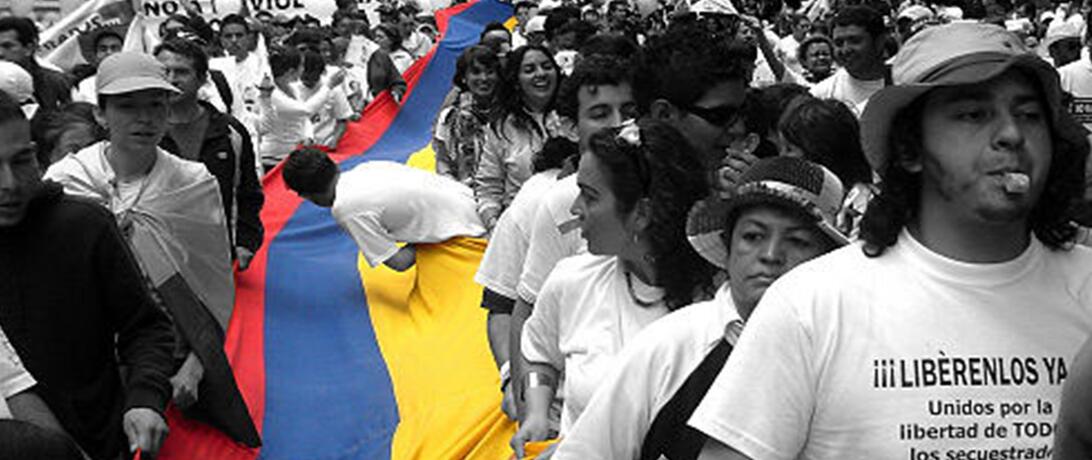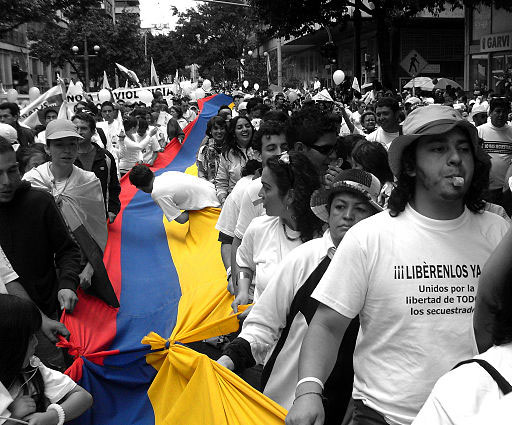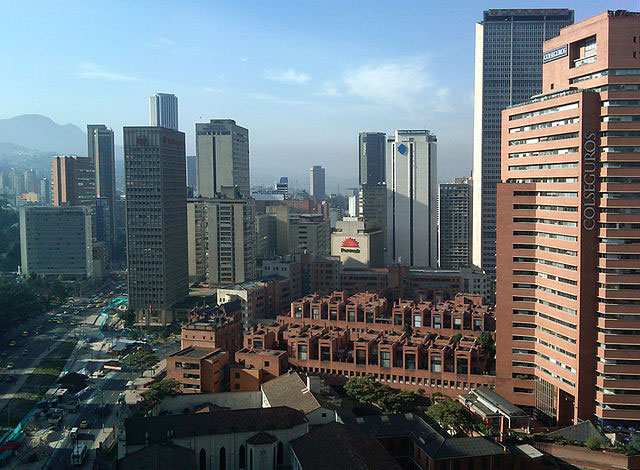
Non-state actors have contributed to the peace process in Colombia over the course of four decades of war.
On July 8, 2012, a violent battle took place between the Colombian military and FARC rebels in the region of Cauca. This violence resulted in the death of one boy, and the displacement of 2,800 civilians. In response to this fighting, an unarmed group of civilians known as the Indigenous Guard demanded that both warring parties leave the area, declaring themselves “in permanent resistance until all armed groups and armies leave our homelands.” Following this declaration, the Indigenous Guard engaged in a high profile confrontation with both the FARC and Colombian military, tearing down barracks and taking weapons from fighters.”
 Stories like this are common in the war in Colombia. Over four decades of war, non-governmental organizations and private actors have contributed to the peace process. These organizations highlight the ways that parties not traditionally associated with war can use their unique position to help reduce violence, protect civilians, and provide new economic opportunities for potential rebel recruits.
Stories like this are common in the war in Colombia. Over four decades of war, non-governmental organizations and private actors have contributed to the peace process. These organizations highlight the ways that parties not traditionally associated with war can use their unique position to help reduce violence, protect civilians, and provide new economic opportunities for potential rebel recruits.
Three types of organizations that have been particularly active in the peace process are peace communities, women’s groups, and business associations.
Peace Communities
In the 1990s, organizations similar to the Indigenous Guard began to form, calling themselves “peace communities.” These groups declared their local communities off limits in the conflict. One peace community in Cacarica featured a rainbow colored, hand-painted sign on its entrance, with the words, “We are a Peace Community, We are special because we do not carry any weapons. No armed actors, whether legal or illegal are permitted in our community.”
These groups fill some unique voids in the conflict space. Rather than using weapons, they have banded together to protect themselves by traveling in groups, attending security meetings, distributing whistles that signal violence, and providing economic opportunities to young people at risk of joining a rebel group. Over fifty of these groups had been declared by the year 2006, some with membership in the thousands.
Moreover, evidence suggests that there are dividends to this approach. For instance, a 2013 study of the Peasant Worker Association of the Carare River (ATCC), one of the oldest peace communities, found that the institution was successful in limiting the levels of violence in the community. In addition to the normal duties of the peace community, the ATCC also advocated on behalf of individuals armed groups suspected of being collaborators. Prior to the founding of the association in 1987, the area had higher homicide rates than its neighboring villages. Following the founding, however, the homicide rate began to trend lower than its neighbors. This provides strong evidence that organizations like the ATCC can effectively protect community members from wartime violence.
Women’s Groups
 Women’s groups have led the charge for peace. Women’s organizations helped initiate initial talks between the Pastrana regime and the FARC in 1999. Women, supported by United Nation’s Security Council Resolution 1325, which formally calls for women’s involvement in peace processes, have remained involved in the peace process through organizations such as the National Peace Council, Thematic Commission, and Women’s Emancipatory Commission. Women’s groups have also worked on truth and reconciliation. When 150 people were abducted from a church in 1999, for example, women’s groups were able to establish a space on a military base, where they worked with the military to track down the missing persons.
Women’s groups have led the charge for peace. Women’s organizations helped initiate initial talks between the Pastrana regime and the FARC in 1999. Women, supported by United Nation’s Security Council Resolution 1325, which formally calls for women’s involvement in peace processes, have remained involved in the peace process through organizations such as the National Peace Council, Thematic Commission, and Women’s Emancipatory Commission. Women’s groups have also worked on truth and reconciliation. When 150 people were abducted from a church in 1999, for example, women’s groups were able to establish a space on a military base, where they worked with the military to track down the missing persons.
Women have used their status as non-state actors to bridge gaps between rival groups and find areas of common ground. Maria Cristina Caballero, an investigative reporter, used her access to areas of the country off limits to many governmental actors to meet with the heads of paramilitary groups on different sides of the conflict. She discovered that these rival leaders actually shared a remarkably similar vision. In one of these interviews, right-wing paramilitary leader Carlos Castano admitted, for the first time, that his group was ready for peace talks (ICIJ).
Private Businesses
In the late 1990s, businesses in Colombia began to realize that the war was hurting their bottom line. By 2003, the conflict had cost the country over 7% of the GDP in each of the previous five years due to the destruction of the infrastructure, capital flight, and increased business costs. This gave the private sector reason to invest in the peace process. According to Fabio Villegas, former president of the financial sector’s association, “the private sector wants peace and is willing to pay for it.”
 Members of the business community have been involved in peace talks with all three rebel groups, offering land to reduce tension with peasants, money to help with demobilization, bonds for investment to end the conflict, and community-building programs such as “soccer for peace.” This program is “meant to promote sportsmanship, gender equality, health, and education… Youth development programs not only focus on children but also have concentrations in community development, involving families and local leaders to create a more sustainable environment for community growth and advancement.”
Members of the business community have been involved in peace talks with all three rebel groups, offering land to reduce tension with peasants, money to help with demobilization, bonds for investment to end the conflict, and community-building programs such as “soccer for peace.” This program is “meant to promote sportsmanship, gender equality, health, and education… Youth development programs not only focus on children but also have concentrations in community development, involving families and local leaders to create a more sustainable environment for community growth and advancement.”
In order to maintain the continued participation of the private sector, these actors must see a return on their investment. There has been a growing sense of frustration among some members of the private sector about the failure to completely end the conflict. In addition, some private sector actors have furthered the conflict instead of working to end it. In 2007 the United States Justice Department imposed a $25 million fine on Chiquita for funding terrorism when it paid the AUC to protect its banana-growing operations. Thus, policy-makers should consider the private sector a potential ally for peace, but make sure that this peace process benefits the private sector.
The three types of group outlined in this post- peace communities, women’s groups, and the private sector- all demonstrate that actors we do not traditionally associate with the peace process can make important contributions. In each case, the actors were able to use their unique status to contribute to peace in ways that governments, intergovernmental organizations, and rebel groups could not. Policymakers would do well to consider this when working to end other conflicts, and actively include these groups in the peace process.
Article Details
Published
Topic
Program
Content Type
Opinion & Insights